Samsung Galaxy Tab S Review (10.5 & 8.4-inch)
by Anand Lal Shimpi on June 24, 2014 9:00 AM EST- Posted in
- Tablets
- Samsung
- Mobile
- Galaxy Tab S
Display
In addition to the dramatically reduced chassis thickness, the move to a Super AMOLED display is the other flagship feature of the Galaxy Tab S lineup. Both devices feature a 2560 x 1600 Super AMOLED panel. The 10.5-inch model features a derivative of the S-Stripe RGB subpixel layout and geometry we first saw in the Galaxy Note 2.
Each pixel features loosely spaced red, green and blue subpixels, with the latter being a thin strip in comparison to the more traditional rectangular red and green subpixels:
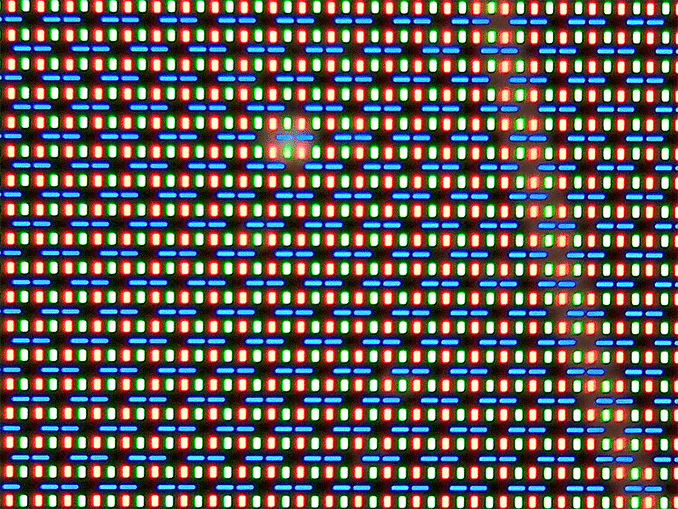
Samsung Galaxy Tab S 10.5, S Stripe RGB
Choosing different geometries for the blue subpixels makes sense as they have lower luminous efficiency than their red and green counterparts. Through balancing of subpixel size and drive power this design should allowed for equal luminance among all three subpixels. The uneven spacing is something new for the Galaxy Tab S 10.5, as the design looked far more structured back in the Note 2 days.
The 8.4-inch model by comparison uses a diamond PenTile RG,BG layout:
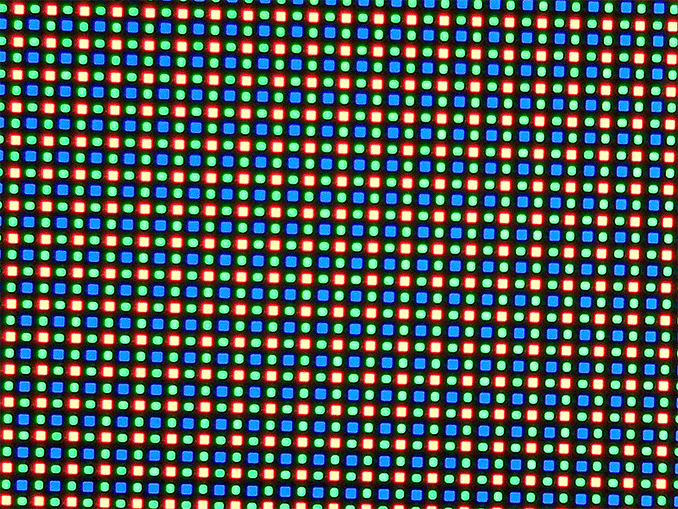
Samsung Galaxy Tab S 8.4, Diamond PenTile
This is similar to what we saw on the Galaxy Note 3, and just like before you get two subpixels per unit pixel instead of three in a traditional RGB stripe. Thankfully the pixel density on the Galaxy Tab S 8.4 is high enough that I wasn’t able to discern individual pixels or be bothered by the diamond PenTile layout. I will admit that I’ve never been the most sensitive to PenTile or PenTile-like sub pixel arrangements, so your mileage may vary.
With the Galaxy S5, Samsung finally delivered a reasonably accurate out of box display calibration as an option. In bringing AMOLED to its tablet lineup, I wondered if Samsung would do the same here. Thankfully the answer appears to be yes.
The new displays have the same adaptive setting as the GS5, which adjusts display tint based on ambient light temperature. There are three predefined color settings, down from the five on Galaxy S5, if you prefer something a bit more predictable.
Although Cinema ends up being the most accurate on the GS5, AMOLED Cinema doesn’t get the same treatment on the Galaxy Tab S. It’s actually the new basic mode that most closely tracks with sRGB. The two AMOLED modes trade off color accuracy for more saturation. I ran our display suite through all of the modes on the Galaxy Tab S 10.5 to illustrate the difference:
| Samsung Galaxy Tab S 10.5 Color Profiles | |||||||||
| Average White Point | Grayscale DeltaE 2000 | Gamut DeltaE 2000 | Saturation Sweep DeltaE 2000 | GMB ColorChecker DeltaE 2000 | |||||
| AMOLED - Cinema | 7540K | 5.2572 | 6.8855 | 5.9306 | 7.0418 | ||||
| AMOLED - Photo | 6576K | 1.7425 | 4.8109 | 4.5933 | 3.3633 | ||||
| Basic | 6516K | 1.8378 | 2.8114 | 2.6195 | 2.4249 | ||||
| Basic (Galaxy Tab S 8.4) | 6294K | 2.3914 | 3.4564 | 2.7639 | 2.2186 | ||||
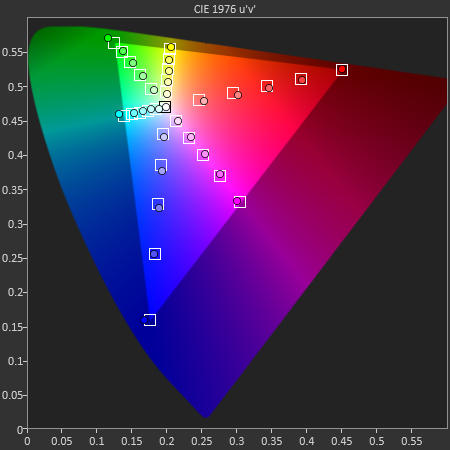
I’ve also included all of the CIE diagrams and test swatch comparisons in a gallery below if you want to have a closer look at what the AMOLED modes do. In short, both the photo and cinema modes oversaturate just in different ways. Photo appears to saturate evenly across all colors, while cinema mode compresses some while pushing out others.
As it’s the most accurate setting, I ran all of our comparison data with the basic mode enabled. In this mode the Galaxy Tab S’ display is among the best we’ve ever tested. On top of having good color accuracy, the new display delivers the awesome contrast ratio that AMOLED displays are known for. As you’ll see later on, there are definite power benefits as well when it comes to watching movies on these displays.
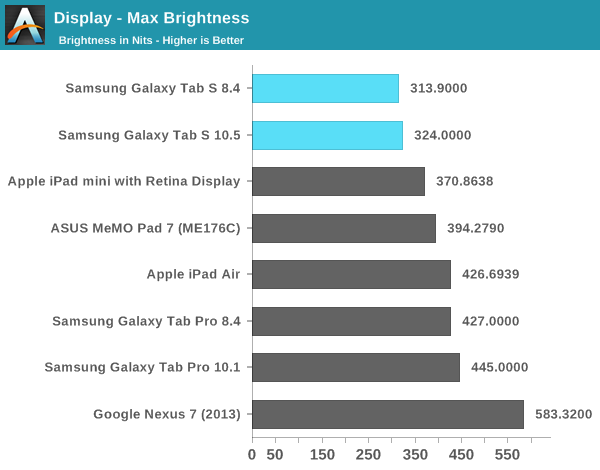
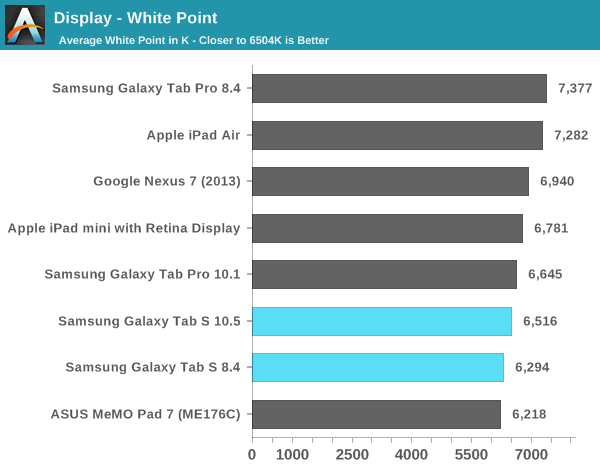
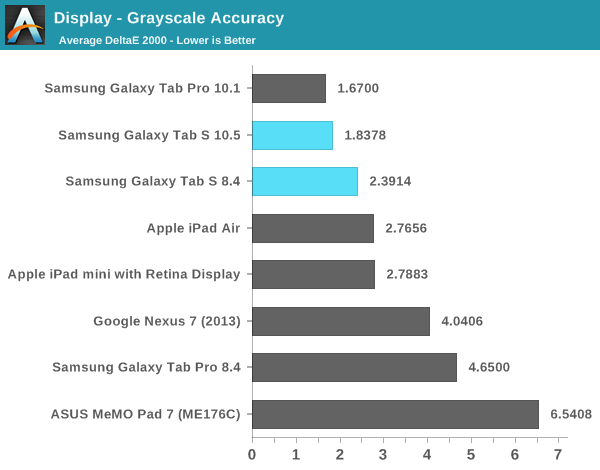
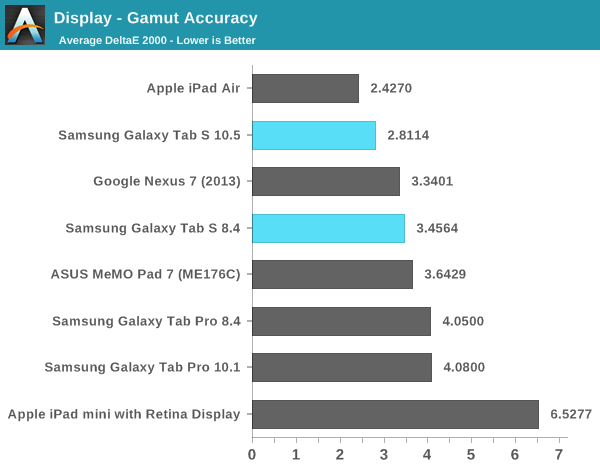

Samsung Galaxy Tab S 10.5 - Basic Profile

Samsung Galaxy Tab S 10.5 - Basic Profile

Samsung Galaxy Tab S 8.4 - Basic Profile

Samsung Galaxy Tab S 8.4 - Basic Profile
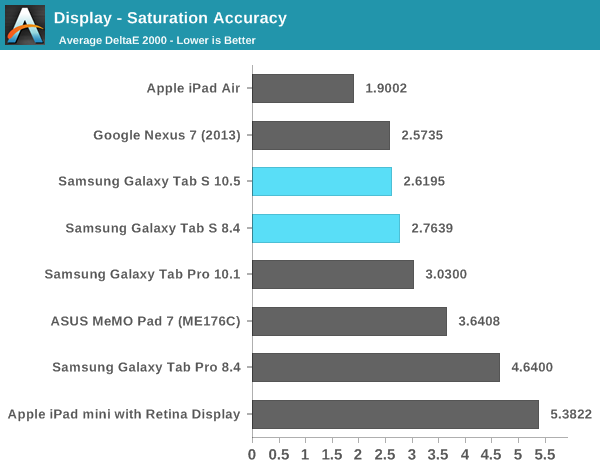

Samsung Galaxy Tab S 10.5 - Basic Profile

Samsung Galaxy Tab S 8.4 - Basic Profile
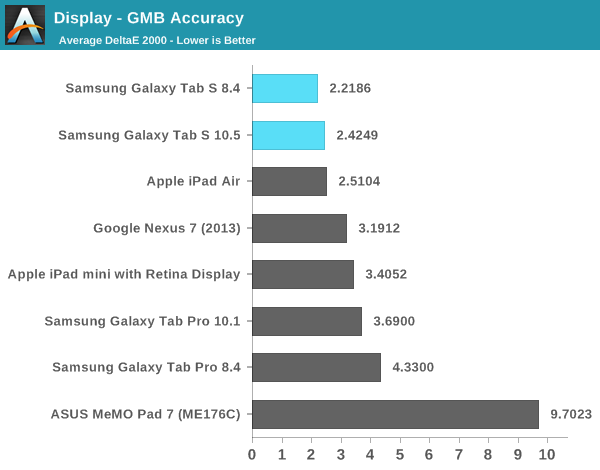
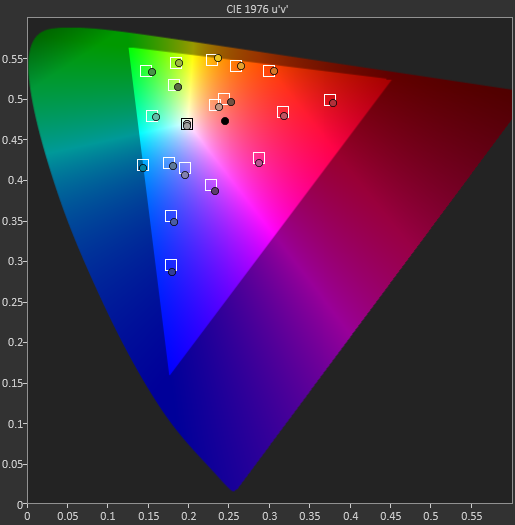
Samsung Galaxy Tab S 10.5 - Basic Profile

Samsung Galaxy Tab S 10.5 - Basic Profile

Samsung Galaxy Tab S 8.4 - Basic Profile

Samsung Galaxy Tab S 8.4 - Basic Profile


















98 Comments
View All Comments
Laxaa - Tuesday, June 24, 2014 - link
I guess we'll se a revamped model in october/november with 805.GC2:CS - Tuesday, June 24, 2014 - link
No... We will see an entirely new tablet lineup called SAMSUNG GALAXY TAB Fretrospooty - Tuesday, June 24, 2014 - link
Then Tab F Pro - all priced too high.hkklife - Tuesday, June 24, 2014 - link
And all will still continue to be gimped with the usual 16GB of internal storage (with 8.5GB available left to the user). It's 2014, not 2011. It's time 32GB became standard across the board no matter what. Also, I wouldn't pay these kinds of prices without having microUSB 3.0 connectivity (I am spoiled by my Note 3) AND wireless charging (to save the aforementioned port from overuse). I'm also slightly miffed by the use of an Exynos instead of a Snapdragon. Now, if they refresh these guys this fall with the latest version of Android, an 801/805, add USB 3.0 from the Tap/Note Pros AND double up the storage while holding the line on the the price then I might consider it!RobilarOCN - Wednesday, June 25, 2014 - link
What does it matter how much storage is on board? For a Nexus 7 or an IPad it matters but Micro SD cards are dirt cheap... I picked up a 128GB for $110 for my Tab Pro. That is a grand total of 144 GB of storage(less OS and Apps) for just over $500. Compared to $800 for a Mini Retina with 128GB that's almost $300 cheaper. As mentioned the USB 3.0 is too thick to fit into this tablet. I have several devices that I have been charging and using for literally years without any overuse of the micro USB port so why worrry?basroil - Wednesday, June 25, 2014 - link
Google got rid of saving to apps to SD cards, so it does matter to those that use large HD optimized appsretrospooty - Wednesday, June 25, 2014 - link
Especially with all the bloatware Samsung puts in it... There will be like 8-9 gb space available for apps. Not good enough Samsung. Not for a $500 device.CanvasExtractor - Sunday, October 12, 2014 - link
10.5GB available for a $400 device, lol. And remember all the bloatware Google Corporation requires, including but not limited to a social network, a chat app, an extra browser, their ad network, a gaming center, and llittle stores and proprietary apps for music, expensive movies, and even magazines.At least Samsung adds things like multi-window, grayscale mode for battery savings, 1% battery.
rodolfcarver - Friday, October 3, 2014 - link
Samsung Galaxy Tab S seems to be a choice, although I personally prefer getting one of the top models from Samsung (see http://www.consumertop.com/best-tablets/ for example), but that's just me. Some people might like this!sigmatau - Tuesday, June 24, 2014 - link
I want to see what the they can do with an 808 or 810 that will be using a die shrink. That is what I am interested in for both phones and tablets. They really should be pushing these chips to be released by years end, not early next year. Oh well.